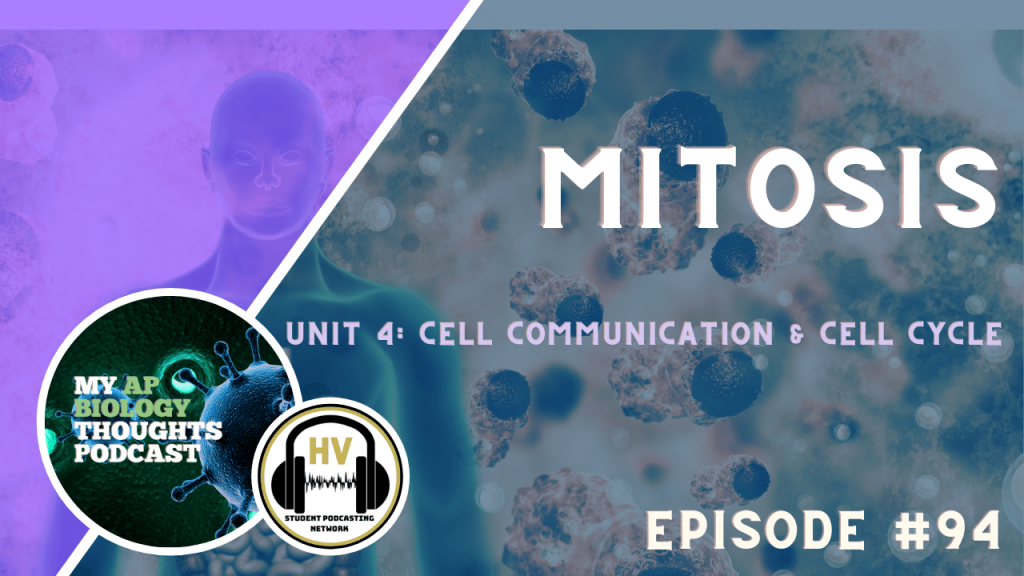Mitosis

My AP Biology Thoughts
Unit 4 Cell Communication and Cell Cycle
Welcome to My AP Biology Thoughts podcast, my name is Adrienne and I am your host for episode #94 called Unit 4 Cell Communication: Mitosis. Today we will be discussing the steps in mitosis and its connection to the cell cycle and regulatory processes.
Segment 1: Introduction to Mitosis
Before we get into the steps of mitosis, lets first define what it is. Mitosis is the division of a cell nucleus to form 2 identical daughter cells. Some important words to know so we can understand this process include chromosome, which consists of 2 identical halves called sister chromatids and are attached by centromere, sister chromatids, which are a single, tightly coiled molecule of DNA, chromatin, which is condensed DNA that coils around protein, and spindle fibers, which attach to the sister chromatids of the centromeres and pull apart the chromosomes.
Segment 2: More About Mitosis
So now that you know those definitions, let’s dive into the steps of mitosis which include prophase, metaphase, anaphase, and telophase. In order for mitosis to begin, each chromosome must have two chromatids that were previously formed during S phase of interphase. In prophase, many processes occur including the chromosomes condensing in order to protect the DNA, the centrosomes moving to opposite poles, the nuclear envelope breaking down, and the microtubules connecting to the centromeres. Next is metaphase where the chromosomes line up on the metaphase plate, which is the plane between the two poles of the spindle. Then, the microtubules pull each chromosome apart into two chromatids. The significance of this step is that it ensures that all DNA chromatids separate when the cell cycle is functioning normally. Then, anaphase occurs where the microtubules shorten and pull the chromosomes to opposite poles so each pole has a complete set of chromosomes that have the same number as the original cell. Lastly, mitosis ends with telophase where it reverses the processes from prophase. The previously broken down nuclear envelope and nucleus begin to reform, the chromatin decondenses, and the DNA unwinds from the histone protein. Specifically in animal cells, a groove forms called the cleavage furrow as the purse strings are tightened and the cell splits into two. At the conclusion of mitosis, two daughter cells are formed, each with two identical copies of every chromosome but each chromosome only has one chromatid.
Segment 3: Connection to the Course
To connect mitosis back to the bigger ideas of cell communication and regulation in unit 4, let’s take a look at how mitosis occurs. One way cells control division is through cyclin-dependent kinases which are enzymes that advance cells past checkpoints. They phosphorylate target proteins in the cell cycle and when activated, they attach to cyclins which change the shape of the enzyme. This sends chemical signals which either turn on or off cell division. For example, mitosis-promoting factor is a cyclin-CDK complex that moves cells through the G2 checkpoint. Since G2 is the phase leading up to mitosis, MPF aids mitosis because it allows the cell to synthesize the nutrients necessary for mitosis to successfully form two normal daughter cells. This demonstrates the relationship between mitosis and cell regulation and division where cell regulatory mechanisms move cells through the cell cycle which eventually initiate mitosis.
Thank you for listening to this episode of My AP Biology Thoughts. For more student-ran podcasts and digital content, make sure that you visit www.hvspn.com. See you next time bio buddies!
Music Credits:
- “Ice Flow” Kevin MacLeod (incompetech.com)
- Licensed under Creative Commons: By Attribution 4.0 License
- http://creativecommons.org/licenses/by/4.0/
Subscribe to our Podcast
Connect with us on Social Media
Twitter @thehvspn

